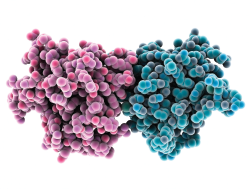
Toll-like receptor complex.
LAGUNA DESIGN / Science Source
Toll-like receptors play an important role in host defense. TLR-7 recognizes viral ssRNA, but also plays a role in the development of systemic lupus erythematosus (SLE). Genetic ablation of a similar receptor, TLR-9, results in opposite effects, with severe disease and kidney involvement. The mechanism of how this works remains unknown.
Anna-Marie Fairhurst, PhD, from the Singapore Immunology Network, and others examined how TLR-9 may suppress the development of severe SLE in a mouse model. The research was published in the October 2018 issue of Arthritis & Rheumatology.1
“It is important to understand … the role of the innate immune system in development of autoimmune diseases to devise new therapies for treating patients,” says Dr. Fairhurst. “Many innovative drugs have come from fundamental research, particularly in immunology.”
TLR-9 Deficient Mice
Dr. Fairhurst and colleagues crossed Sle1 lupus-prone mice with TLR-9-deficient mice, resulting in Sle1TLR-9-/- mice. Autoimmune disease manifestations, including kidney disease (or glomerulonephritis [GN]); autoantibody and total Ig profiles; and immune cell activation, were assessed at 4.5–6.5 months. Functional B cell studies, including Ig profiling and measuring TLR-7 expression, were completed pre-disease, at 8–10 weeks.
“Sle1TLR-9-/- mice were compared with the Sle1 mild autoimmune-prone strain,” says Dr. Fairhurst. “These mice develop antibodies, but not kidney disease.”
Sle1TLR-9-/- mice developed severe disease similar to that seen in TLR-9 deficient MRL and Nba2 models. They presented with splenomegaly due to an expansion of all major leukocyte subsets. Increases in CD138+B220- plasma cell numbers and decreases in the frequency of marginal zone B cells were observed. These are characteristics of lupus models overexpressing TLR-7. CD4+ and CD8+ T cells had a more activated phenotype in Sle1TLR-9-/- mice.
Pathological examination showed the majority of Sle1TLR-9-/- mice had class III-IV GN characterized by segmental to global endocapillary proliferation of the glomeruli. This was confirmed by increased serum BUN and urinary proteins.

Dr. Fairhurst
TLR-9 deficiency in Sle1 mice skews the autoantibody profile toward RNA-associated antigens. Further analysis using a HEp-2 cell assay showed serum antibodies in Sle1TLR-9-/- mice bound mostly to cytoplasm with some nucleolar specificity. All Sle1TLR-9-/- mouse sera lost the ability to bind mitotic chromatin.
In contrast, Sle1 mouse antibodies were binding to the nucleus. The cytoplasmic HEp-2 staining pattern of Sle1TLR9-/- serum was similar to RNA-
reactive autoantibodies. Multiplex assays of immunoglobulin (Ig) levels indicated TLR-9 deficiency resulted in higher concentrations of IgG2a/c, IgG2b and IgM autoantibodies compared to Sle1 controls.
Analysis of intracellular TLR-7 protein showed a systemic increase in expression in Sle1TLR-9-/- mice. TLR-7 levels were significantly higher in B cells, pDCs, CD11b+ DCs, macrophages and in CD11c+MHCII-precursors compared with Sle1 controls.
Humoral Immune Changes
Given the increases and switch in specificity in the antibodies of Sle1TLR9-/- mice, the authors went on to assess the humoral immune changes. They assessed B cell responses to TLR-7 in young mice that had not developed the disease.
Flow cytometry assays measuring B cell survival, activation and proliferation detected no differences between the two strains of mice. Further, they did not find increases in TLR-7 protein in young mouse B cells. However, samples collected on Day 4 revealed significantly higher amounts of IgG when stimulated.
Staining of freshly isolated splenocytes revealed Sle1TLR-9-/- mouse B cells expressed more surface IgG than the Sle1 mice. The frequency of CD138+ plasma/plasmablast cells were increased with significantly higher TLR-7 levels when TLR-9 was absent.
They detected increased frequencies of splenic CD11b+ DCs with higher TLR-7 expression in experimental mice. This suggests TLR-7-high DCs have a role in the increase of CD138+ plasma/plasmablasts and IgG-switched B cells in negative mice. Because extrafollicular plasmablast and antibody switching in lupus have been attributed to DCs, this could be an interesting area to pursue.
Unexpected Results

Dr. Buyon
In SLE, the disease develops through chronic inflammation. Stimulation of TLR-7/TLR-9 results in immune activation through a common pathway. However, deletion in mice gives opposite results.
“Unexpectedly, TLR-9 deletion causes disease exacerbation in multiple spontaneous and induced lupus models,” says Dr. Fairhurst. “It is not known why. We found deletion of TLR-9 in our lupus-prone model resulted in up-regulation of TLR-7 expression and chronic disease.”
In particular, their data showed the pathogenesis of kidney disease was characterized by infiltrating renal conventional (c) DCs overexpressing TLR-7. The majority of infiltrating cells in the Sle1TLR-9-/- mouse kidneys were myeloid (CD11b+). These were made up of MHCII-, F4/80+ macrophages and F4/80- cDCs. The MHCII- and the F4/80- cDCs increased in deficient mice compared with controls.
Kidney DCs or macrophages were pulsed with an antigen (ovalbumin; OVA) and then cultured with OVA-specific T cells to trigger activation. Renal cDCs from Sle1TLR9-/- stimulated more T cell proliferation than cDCs from Sle1 mice. Renal macrophages showed no augmentation in T cell proliferation. Both renal DCs and macrophages had higher TLR-7 expression in the absence of TLR-9.
The researchers analyzed results from younger mice with less disease. Expression of TLR-7 was increased in the deficient mouse kidney F4/80+ macrophages and F4/80-/low DCs. No increase was seen in MHCII- cells, similar to older mice.
TLR-9 Deletion Not Model Specific
“The fact that TLR-9 deletion across multiple models results in severe nephritis says it is not model specific and that there is a fundamental mechanism in the mouse where TLR-9 suppression suppresses inflammation,” says Dr. Fairhurst. “This pathway probably also exists in humans, but whether TLR-9 plays the dominant role remains to be seen.”
For SLE patients, many of the existing therapies treat symptomatic effects with limited effectiveness. The researchers think targeting TLR-7 may go to the root cause of SLE by stopping inflammation leading to kidney disease.
“I would hope this stimulates more questions and furthers interest in the mechanism of disease progression,” says Dr. Fairhurst. “Further understanding of immunology helps us understand the disease and perhaps to harness pathways for autoimmunity.”
Well-Done Study
Jill Buyon, MD, is division director of rheumatology at the New York University School of Medicine. She thinks this well-done study will be useful when considering therapeutic candidates for SLE treatment.
“Previous murine studies have supported a suppressive role for TLR-9 signaling in lupus,” she says. “What the authors have shown, rather elegantly, is that when TLR-9 is knocked out in a lupus-prone mouse, severe autoimmunity develops, characterized by splenomegaly and kidney disease. Importantly, TLR-7 expression was increased in inflammatory cells present in the kidney and this was apparent prior to clinical disease, a finding that may provide insights into early treatments to prevent full-blown lupus nephritis.”
The results suggest the TLR-7 pathway is a key perpetrator of disease and that TLR-9 is important to provide a suppressive influence. TLR-7 seems to be responsible for many autoimmune responses seen in lupus.
“In this mouse model, the autoantibody repertoire was skewed toward RNA‐containing antigens, including anti-Ro and La antibodies as well as anti-Sm antibodies,” says Dr. Buyon. “Often, really elegant research raises new questions, and this work certainly draws attention to antibodies clinicians usually consider less concerning than anti-dsDNA antibodies with regard to renal disease in human lupus.
“But what I take away from this research is that suppression of TLR-7 should be considered early in the course of disease.”
Kurt Ullman has been a freelance writer for more than 30 years and a contributing writer to The Rheumatologist for more than 10 years.
References
- Celhar T, Yasuga H, Lee HY, et al. Toll-like receptor 9 deficiency breaks tolerance to RNA-associated antigens and up-regulates toll-like receptor 7 protein in Sle1 mice. Arthritis Rheumatol. 2018 Oct;70(10):1597–1609.